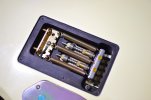Drew
Forum MVP
May as well add some content here:
Really hard to do this perfectly scientifically - I'm not playing the exact same riffs, I can't guarantee my pick attack is identical ehre... but it WAS the same strings and same amp settings, and to my ears there's a HAIR more presence to the attack here. Whether or not that's a good thing is subjective; honestly listening now on what's probably not a great monitoring chain, I might prefer the slightly rounder stock blocks. For me though this was about durability more than tone, so...
Really hard to do this perfectly scientifically - I'm not playing the exact same riffs, I can't guarantee my pick attack is identical ehre... but it WAS the same strings and same amp settings, and to my ears there's a HAIR more presence to the attack here. Whether or not that's a good thing is subjective; honestly listening now on what's probably not a great monitoring chain, I might prefer the slightly rounder stock blocks. For me though this was about durability more than tone, so...


 My bad on that one.
My bad on that one.


